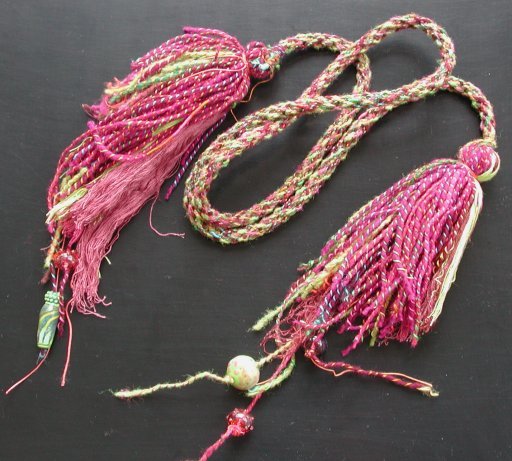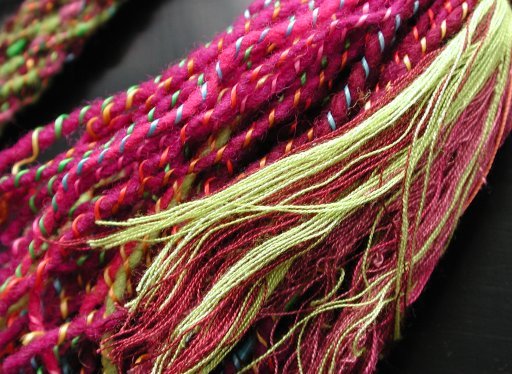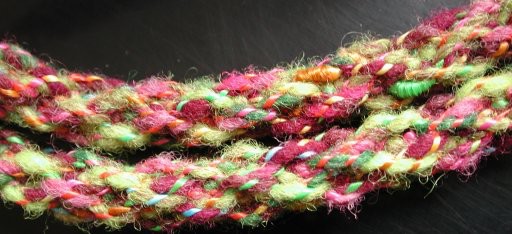Though I've made braids out of fuzzy materials before, and, given my approach to a lot of other media, the gentle reader could be forgiven for thinking it'd be a natural for me I have for a long time felt heavily textured fibers disguised the beauty of the braid structure (even going so far to characterize one such braid by a well known kumist as ‘leprous’).
So this isn't a yarn I would've chosen on my own, but a friend wanted to make a knitted and felted purse. The yarn she chose was a hand spun single ply—very beautiful, but I've tried braiding that stuff before, and it just pulls apart on the marudai. Therefore I selected a co-ordinating yarn, that had little synthetic ribbon-like stuff wrapped around it, which I thought would hold it together. Like the yarn it was to match it is a hand-dyed fiber, but unlike the hand-painted yarns I'd worked with up to now, there wasn't really any repeat—the ball simply had 4–5 colors, fuscia, burgundy, pine green and lime/avocado green more or less joined together. I had to rethink my braid pronto.

So I ended up putting a single color on each bobbin (more or less—sometimes a length would incorporate the shift from one color to the next, though sometimes the yarn simply just ended, and the skein took up with the new color without the ends even being tied together). My friend really liked the oimatsu (old pine tree [bark]) pattern, which is basically 2 sets of 8 bobbin kereiko no himo (i.e. twill) alternating for three repeats. The resting bobbins create the outer ribs, and in fact the pattern was a good choice, being bold enough to show through the yarn effectively. This braid is only documented in Catherine Martin's book, so far as I know, and the idea of resting bobbins isn't really explored much elsewhere (Owen gets some similar and interesting effects by varying the thickness of the ends per bobbin and weight of the bobbins.)
I warped nearly the whole skein on the marudai, and had about a yard long piece of braid leftover, to which I added extra yarn and Vietnamese floss, not to mention odds and ends of bullseye and satake glass beads in co-ordinating colors. The upshot, therefore, is that I liked my fuzzy braid, surprisingly so—and, looking back at some other fuzzy braids, I've concluded this liking has more to do with an expanding vision of what I like than any particular improvement in my skills.
C'est la vie. (And maybe that braid of Carey's isn't so leprous after all...nah, still don't like it. Ugh. Some things stay the same.)
wool, viscose?; tassels also include imported French mixed-fiber floss (bought in Vietnam!) and glass beads. Braid is 1m long by (about) 1cm thick, with the bulk of the tassels perhaps 8–9inch; though including the long beaded strands, they top out at about 13” (roughly 26cm) long. Bullseye and lead satake glass beads. Started (and completed) during winter months of 2005.
Originally created 29–30 mar 05
Unless otherwise noted, text, image and objects depicted therein copyright 1996--present sylvus tarn.
Sylvus Tarn
